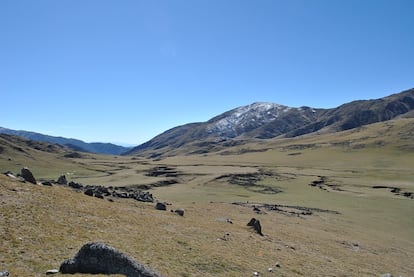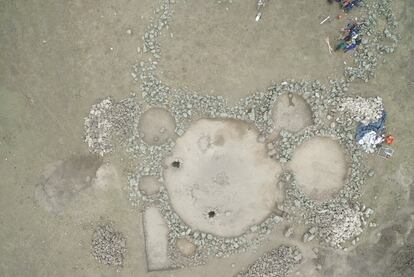The Tafí: a thousand years of peace and social equality in the Andes
The Formative Period culture developed agricultural and commercial systems without hierarchical or military structures

The Tafí, a community dating from the Formative Period (the American archeological equivalent of the Neolithic period), populated the Andean area that links Argentina, Chile, and Bolivia for nearly a millennium, until the year 800 A.D. At more than 1,800 meters above sea level, among peaks, jungles, and forests, they built interconnected villages, in which no one house stood taller than the others. The archaeological remains left behind by the culture show no evidence of class distinctions, no palaces, no residences for those responsible for religious ceremonies, or centers for the accumulation of wealth. Neither are there any fortifications or military devices, so it is feasible to assume the Tafí never engaged in conflicts or wars. In a historical period in which incipient agricultural production produced hierarchical systems based on power and wealth, the Tafí constitute “a very stable society that for hundreds of years successfully perpetuated an economic and social model of equality,” says Ignasi Grau, professor of archaeology at the University of Alicante (UA).

This is not an unusual model, says the expert. “It is an issue of study,” he says. “Since we tend to focus more on hierarchical societies, we look for the outstanding, the exceptional and wealth, but selfishness is not a law and it is as normal to find equality as inequality.” Grau stresses that archaeology “tends to study societies in which there are selfish people, with the will to appropriate production and its surplus,” a system that was born in the Neolithic. But at that same time “there were other trajectories, such as that of the Tafí, in which collaborative behaviors and wealth distribution functioned. While in other environments some families begin to control the food surplus and the development of technology, and the chiefdoms, kings or priestly castes emerge,” — a period that is considered the seed of the capitalist economy — “the Tafí developed their economy without visible hierarchies.” In that respect, it is a civilization like that of Teotihuacan in Mexico, “a city without leaders, larger than imperial Rome, with two huge pyramids dedicated to the Moon and the Sun, but structured in a cooperative way.”
A team of archaeologists from the UA, the National Scientific and Technical Research Council (CSIC) and several other Argentinean scientific and academic institutions traveled to the Ciénaga Valley in Tucumán (Argentina) to study the Tafí in a program funded by the Spanish Ministry of Culture, which began in 2021. In the field, they will map the villages of this Andean civilization and excavate some of its dwellings, which took the form of a common central circle around which there were as many rooms as the number of family members living there required. “Like other Neolithic cultures,” Grau points out, “the Tafí developed a complex agricultural system, in their case based on the production of corn or potatoes and the exploitation of llamas or guanacos.” It was a society “that traded with other nearby cultures to exchange their products,” which included cebil, “a psychotropic plant that they used for their rituals.” They lived without the need for “fortifications, defensive structures or walls.”

In addition to the structure of their homes, researchers have detected more signs of equality in the artifacts left behind by the Tafí. “Each village has a ceremonial mound,” like the one at La Ciénaga, which was probably built as a cooperative effort among all the citizens and “where rituals, community social practices or festivities were celebrated. A relationship of family cohesion, of union, was established in which they performed work for the whole village, such as cleaning irrigation ditches, for example,” says Grau. In this way, “the system helped people feel there was no need to appropriate common assets.”
Another of the aspects the researchers will investigate is the possibility that this equality also took gender into account. “The Tafí gave great importance to their homes, which is the feminine environment par excellence,” says Grau, “so they could have given the same importance to those who rule them, women, who are also responsible for the production of handicrafts, which generates wealth.” Likewise, they will attempt to establish “whether the ancestors they worshiped were men or women. When you live in an egalitarian mold, the model works both in social and interpersonal relationships,” so that, in Grau’s opinion, it is likely that “the figure of the woman was recognized.”
Sign up for our weekly newsletter to get more English-language news coverage from EL PAÍS USA Edition
Tu suscripción se está usando en otro dispositivo
¿Quieres añadir otro usuario a tu suscripción?
Si continúas leyendo en este dispositivo, no se podrá leer en el otro.
FlechaTu suscripción se está usando en otro dispositivo y solo puedes acceder a EL PAÍS desde un dispositivo a la vez.
Si quieres compartir tu cuenta, cambia tu suscripción a la modalidad Premium, así podrás añadir otro usuario. Cada uno accederá con su propia cuenta de email, lo que os permitirá personalizar vuestra experiencia en EL PAÍS.
¿Tienes una suscripción de empresa? Accede aquí para contratar más cuentas.
En el caso de no saber quién está usando tu cuenta, te recomendamos cambiar tu contraseña aquí.
Si decides continuar compartiendo tu cuenta, este mensaje se mostrará en tu dispositivo y en el de la otra persona que está usando tu cuenta de forma indefinida, afectando a tu experiencia de lectura. Puedes consultar aquí los términos y condiciones de la suscripción digital.
More information
Archived In
Últimas noticias
Most viewed
- Sinaloa Cartel war is taking its toll on Los Chapitos
- Oona Chaplin: ‘I told James Cameron that I was living in a treehouse and starting a permaculture project with a friend’
- Reinhard Genzel, Nobel laureate in physics: ‘One-minute videos will never give you the truth’
- Why the price of coffee has skyrocketed: from Brazilian plantations to specialty coffee houses
- Silver prices are going crazy: This is what’s fueling the rally











































